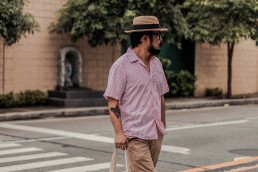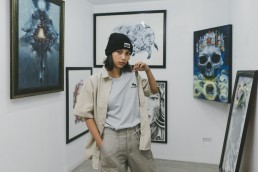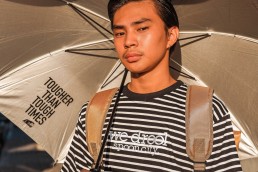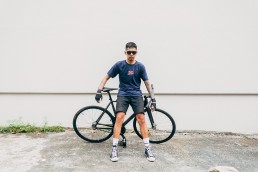
While the proliferation of social media use has massively expanded the size of our potential communities, a finger to the sky reveals that it’s left our experience of life more solitary. It’s ironic.
Within this online framework, however, there are creatives in commerce re-channelling energy towards community, drawing on their resources and positioning brands as kindle for real human connection. In the case of Norway-based photographer and producer Michael Ray “Mike” Vera Cruz Angeles, the concept of community-driven is at the core of each project he touches, be that his work at creative studio Also Known As, with multi-time Norwegian Grammy Award (Spellemannprisen) winning group Karpe, or at Mike’s Corner, his own bodega and deli.
“I guess that’s how you get longevity,” says Mike, “because if you get a community thing going on, people feel like they’re a part of it. And when they keep it close to their heart, they want to make it private. They want to see it shine and […] that’s a good way to make sure that it truly becomes something for everyone.”
Consumers want involvement. They want representation. They want to find spaces within brands they support to connect with like-minded people. Since he picked up a Nikon camera in 2008, Mike has jettisoned himself out of a career in physical therapy and into capturing and representing urban pop culture in Norway–documenting moments with artists, streetwear, food, and hip-hop music. It’s from this feel, this direct interaction with many of Norway’s artists, that Mike and the creatives at Also Known As have a sense of how energy flows in the huge, obfuscated consumer-segment known as youth.
“The clients,” says Mike, “they see that we’re more than just a studio. We’re also a presence in the realm that they want to do some damage [in], and so I guess that’s why they […] go to us because they know that we understand the mechanics of how to get that type of people to go with their product.”

“When I came to Vegas, it was weird if you weren’t into sneakers. So the culture that I loved, I had in front of me now.”
Partaking in a culture that’s not in your milieu
Perhaps that’s another way of saying ‘living on the internet.’ Maybe that’s a longhand for globalisation.
Growing up in Oslo, in a Filipino household, Mike sensed levels of being different. “It wasn’t bad at all because the kids that I grew up with, they didn’t really care […] that I look different,” he says, “but no matter what, you feel different, right? And […] culture wise it’s way different [in Norway].”
It’s common in Norway to go on student exchange as early as highschool. With some family around the United States, Mike jumped at the opportunity and after negotiating his way out of a Portland exchange, ended up living in Las Vegas for a year. Though Mike looks back and describes the Neon Capital of the World as the Weirdest Place in the World, he looks back on the year as “[opening] up [his] whole creative streak.”
“I [followed] American culture ever since I was a kid,” he says, “from the cartoons, to Fresh Prince, to NBA basketball.” With the help of the internet, sneaker trade, Niketalk.com, and online forums, were accessible temples of obsession for Mike. But these weren’t temples receiving veneration from large communities of youth in Norway.
Vegas was an alternate universe–where football was replaced by basketball and where the full force of camping outside sneaker stores for limited edition scores reigned supreme. “When I came to Vegas,” recalls Mike, “it was weird if you weren’t into sneakers. So the culture that I loved, I had in front of me now.” It wasn’t stuck behind a monitor.
Coming back to Norway after a year’s worth of immersion, Mike held this notion of the culture close to his heart. It was in it that he wanted to find work and in that process, a community.

akam1k3
“I started with a screen name, ‘akam1k3’,” Mike laughs. “Nobody understood what it was.”
Wielding the chosen screen name, Mike built a blog aimed at documenting his life in Olso. Again, we circle back to streetwear, food, and hip-hop music–pieces of the puzzle that make up the mosaic of youth culture. “I was still young,” says Mike, “so I couldn’t go into all the clubs but, I remember photography of the club scene was coming up and then fashion was also coming up. Everybody was into streetwear.”
Mike would post pictures from parties on the blog, pictures of his friends and creatives. ”For some reason,” he says, “a lot of them turned out to become [some] of the biggest artists in Norway and then I was the one to document it.”
“I’ve basically documented urban culture [and] streetwear culture in Norway since 2008.”



Forming a crew called Halo-Halo with a cousin and friends, Mike and company would “halo-halo” their clothes, hang out, and take pictures at the time, which he recalls, everybody was rocking the M.I.A. type of clothing. “That actually gained a bunch of traction for us,” he says, “And then I guess it created somewhat [of] a name [for us]. Early influencing, I guess that’s what it was called.”
Looking back on his photography work from this period, Mike sees a trace through the history of this culture in Norway. “I’ve basically documented urban culture [and] streetwear culture in Norway since 2008,” he says. He recalls a time when seeing someone in Dunks was a real event. “You feel like you could have an actual conversation with them because nobody else wore Dunks,” he says. “I know that we know the same thing.” Now, it’s a more commonly-worn shoe; that is, wearers are no longer asked why they’re wearing “hospital shoes”.

Karpe saw the value of community involvement in the music industry
And Mike has been shooting for them since 2012. “It was because of the blog,” motions Mike.
The “DM” hadn’t yet been invented and so Twitter was a space where you could unleash the entirety of your opinion on someone else’s wall. “I remember you could just write to people and since nobody had too many followers you could actually see all your followers and you could follow up on them,” says Mike. In what was an emerging and small online creative scene, Mike and Karpe, already a Grammy-awarded group at the time, began talking.
“They saw my blog and they felt like it was cool,” says Mike. “It was really like an organic type of way to take photos. They would say [you kind of] felt like you were part of the photo or part of the moment that [it] was taken.”

Karpe, the rap duo of audiovisual artists Magdi Omar Ytreeide Abdelmaguid and Chirag Rashmikant Patel, asked Mike to shadow and document their day-to-day during their release concert and while they were working on a new album. “They’re really smart, man,” says Mike. “They knew that the next thing should be to let people into their lives. Not too many people did that yet.”
It was the birth of inviting their musical consumers into the ongoings behind what comes across in the music–or even live. “I remember flying out to Stockholm,” says Mike. That’s where he got to shadow the duo for the production and studio time. After that, Mike’s work was supposed to be done.
“Let me try to do some concerts,” he remembers. “‘All right, but we don’t have the economy to just bring you on tour’ they said that because nobody just had a random guy as a photographer.”
But this was around the time Instagram had just come out, and Mike was keen to have this form of content for the community “pop.” It did.
“One of the rappers in the group said to one of the biggest news channels [in Norway] when they had an interview that I was like a drug dealer. I gave them the first hit for free and then after that […] they were addicted because the whole visual identity was through my pictures.”
Karpe released a tour book with photos Mike took in 2013, and since meeting the duo in Stockholm, Mike hasn’t missed a tour. “We did the biggest region run last year,” says Mike. “We did 10 Arena concerts. Sold them out.”



Food, creative production, and the community
In the process of putting the tour book together, Mike worked closely with Even Suseg. Having chanced upon a creative partnership that worked, Even and Mike took more projects on, eventually meeting their film director Thomas Flått and formalising Also Known As in 2018. Celine Engh Lilleng too joined the group as PR and Communications Manager.
“We can deliver something different in the market,” says Mike, “because I feel like we touch a nerve that nobody can touch.” As a culture-driven creative studio, Also Known As has worked with musical artists, clothing brands, technology companies, and big names (think FIFA and Adidas), consistently challenging their clients to explore new avenues of intertwining their products with a changing new market.
“We did this Red Bull thing […] a long time ago, but we used that project to show people that it’s possible to just challenge and do something way different,” says Mike. Releasing a new line of organic sodas, rather than the traditional take pictures, release photos, and have customers buy, Mike and team said “Nah, let’s […] make those four cans into four teams and make [an] outfit for all the [four], like clothes and shoes for each flavour and then we can do an event with a pop-up.”
The best part? They recommended not to put ‘Red Bull’ on the clothing at all. Challenged, but eventually convinced, Red Bull pushed through. “It’s fun,” Mike recalls, “because then the people could actually see that people wanted to be a part of that idea.”

“It’s always been a dream to have a place where like minded people and different people can just meet and share experiences, memories and all that especially over a good meal.”


Inclusion. Loyalty.
Themes fused into the fabric of Mike’s surprise food venture. “I would never do it again.” Mike laughs and asserts that he was kidding. “It’s always been a dream to have a place where like minded people and different people can just meet and share experiences, memories and all that especially over a good meal.”
Recently, Late Night Stand Up has come back to Mike’s Corner. “It’s like a stage for new comedians to just break,” says Mike, “and then it’s also a nice stage for the veteran[s] to try out new material.” It’s a piece of the fabric holding the corner together as a community-based thing. “I want people to just hang out,” he says. “You don’t have to eat food to be there. [I just want to] make sure people feel like this is the hangout spot.”

And that’s a bit trickier given the place’s location. It’s in a business district–”a rather posh place” if you look at it. “People think that you’ve got to have money to rock over there[…],ever since we were kids, we never felt like we could really be a part of that place. Not really welcome. So when they gave us the opportunity to open up the restaurant, at the new spot, I felt like it was kind of our job to make sure that the people that look like us and the kids that come after us would feel welcome,” says Mike.
The owner of the spot from whom Mike is leasing mentioned that he’s never seen so many folks in hoodies around the area to which Mike replied, “That’s a good thing, man. Because that’s when you know you upset the setup […], you want people to have the same chances everywhere.”
Caught in a delicate balance between projects, fatherhood, and being the best boyfriend he can be, Mike points to the support from family and friends–and of course skilled collaborators–in keeping everything moving along. That doesn’t stop him from describing his schedule as “chaos.” The motivation runs deep, beyond the will to work hard instilled in him by his parents, but too from the responsibility Mike feels for the next generation of creative talent in the scene.
“I really want to do more community-driven projects,” he says. “I see where it brought me and I feel like now more than ever, social media makes it even harder for people to dream because you see so many good people in front of you or on your phone all the time. And if you don’t feel like you can do that at a certain age or a certain level […] I feel like these kids just move to the next [thing]. I feel like [if we can’t] help cater for young talent or a young community, we might miss out on some great, great individuals or great people.”

CREDITS
WRITER Jaymes Shrimski
EDITOR Tricia Quintero
PHOTOGRAPHER Sture Nordhagen Gjermundsen
SPECIAL THANKS George Balobalo
SUPPORT PURVEYR
If you like this story and would love to read more like it, we hope you can support us for as low as ₱100. This will help us continue what we do and feature more stories of creative Filipinos. You can subscribe to the fund or send us a tip.




